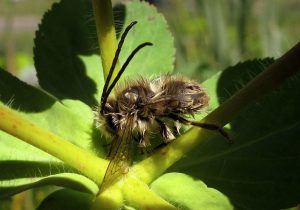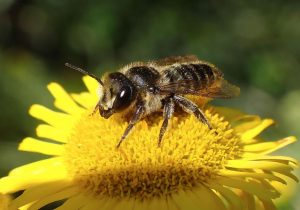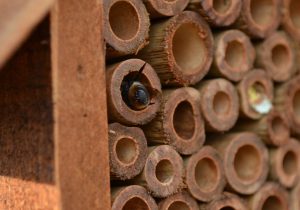
Lonely bees?
Lonely bees? Learn more about these species with Fabiola Cardeña.
Today I come to talk to you about extraordinary pollinating insects such as solitary bees. Did you know that there are a little more than 20 thousand described species of bees in the world? And that, of that total, 75% of these live a solitary life? To get into the subject, we must make it clear that there are, broadly speaking, three large groups of bees; the most famous when we hear the word bee are the social ones, where the typical image of hundreds or thousands of workers work- ing and fulfilling their role within a hive to selflessly protect, feed and gather nesting materials to help with the offspring of their queen comes to mind.

Eucera
Photography: Jacinta lluch valero vía Flickr, www.creativecommons.org, (CC BY-SA 2.0)
Another group of bees are the famous parasitic bees responsible for stealing entire hives or workers to create their own offspring, and finally, the group we are here for: the solitary bees.
This magnificent group of bees where the female builds her own nest, defends it from intruders, parasites and predators, looking for her own food such as pollen, nectar or floral oils for both herself and her offspring. We could call them nature’s empowered single moms. They exhibit extraordinary diversity in morphology, mating behavior, life history, nest building architecture, unique foraging behaviors, so much diversity we would need an entire book for them. Another difference between social and solitary bees is the period of adult activity. What does this mean? Solitary bees can live from a few weeks to a month, often coinciding with the availability of floral resources, especially when they are pollinators of a specific plant (plant-host relationship), so they are “hurried” to generate offspring in a short term, in a few words, time is everything for them; unlike the social ones that can have several generations in the same year.
The vast majority of these bees nest under- ground with burrows up to five meters deep, others modify pre-existing cavities where they transport suitable materials for nesting, now, depending on the species the material, their choice will depend on making the nest comfortable for their offspring. There is another type of solitary bee that dig nests in wood, also, there is a record of them in cities where they make their nests in small holes the size of a screw or where there was once a nail, we just have to pay attention to our surroundings to realize the presence of these magnificent pollinators. Choosing their nesting site is an important decision for them, since during their development they are confined to one place.

Megachile
Photography: Anne Marie vandam vía Pixabay
They are extremely fragile species, especially when they are specialized to a single type of flower for their food. In addition to this, there are the different threats that these pollinators face, such as those caused by environmental disturbances or those of anthropic origin such as the misuse of pesticides, climate change or the introduction of species into their habitats that border them on scroll to its disappearance. There is still much to talk about these magnificent bees, however, I believe that this has been a good introduction to give them some of the spotlight they deserve so much for being one of the most important and determining pollinators for wild and cultivated plants, as well as for the regeneration and integrity of our planet’s ecosystems.

Casa de abejas / Bee house
Photography: Pxhere.com











